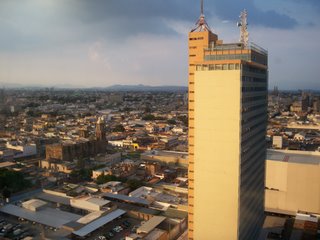BARRIOS AND HISTORICAL CENTER

Picture of Mexicaltzingo from above, picture taken by t.watkin/2006.
Some elements about the 'barrios' of Guadalajara, and the historical center the city.
La relación necesaria entre identidad urbana y sostenibilidad posible
Este artículo revisa algunos aportes a la caracterización de la identidad social y urbana, para luego relacionarla como precondición a la posibilidad del desarrollo sostenible en la ciudad. Discute de manera crítica el concepto de sostenibilidad y sus implicaciones, lo cual forma parte de nuestro trabajo en el proyecto de la red cis (descrito en artículo de este dossier), a la que estamos integrados. Hacemos una referencia descriptiva de algunos de los resultados preliminares en dos barrios populares de Guadalajara (uno consolidado y otro reciente), en los que se realizó el estudio exploratorio, y en los que con anterioridad efectuamos varios estudios e intervenciones iniciales (Jiménez, 1991; Jiménez, 1995), y al final se establecen algunas relaciones y posibles conclusioneS.
FOR FULL ARTICLE CLICK HERE
Cambia el Centro su fisonomia
source: Mural, 07/09/2004
FOR FULL ARTICLE CLICK HERE
Add other articles sending comments for references and sources related to this topic.

5 Comments:
Defining elements of the new urbanism :( and they have to be a lot to the sense of belonging to somewhere)
The heart of new urbanism is in the design of neighborhoods, which can be defined by 13 elements, according to town planners Andrés Duany and Elizabeth Plater-Zyberk, two of the founders of the Congress for the New Urbanism. Duany and Plater-Zyberk, a husband-wife team, both studied and met each other at the internationally renowned Yale School of Architecture in New Haven. While living in one of the Victorian neighborhoods of New Haven, they observed authentic neighborhoods and mixed-use development streetscapes with a tremendous amount of character, corner shops, front porches, and a diversity of well-crafted housing. The experience living in New Haven, one of the most historic cities in the United States, formed the basis of their ideas. An authentic neighborhood contains most of these elements:
The neighborhood has a discernible center. This is often a square or a green and sometimes a busy or memorable street corner. A transit stop would be located at this center.
Most of the dwellings are within a five-minute walk of the center, an average of roughly 2,000 feet.
There are a variety of dwelling types—usually houses, rowhouses and apartments—so that younger and older people, singles and families, the poor and the wealthy may find places to live.
At the edge of the neighborhood, there are shops and offices of sufficiently varied types to supply the weekly needs of a household.
A small ancillary building or garage apartment is permitted within the backyard of each house. It may be used as a rental unit or place to work (for example, office or craft workshop).
An elementary school is close enough so that most children can walk from their home.
There are small playgrounds accessible to every dwelling—not more than a tenth of a mile away.
Streets within the neighborhood form a connected network, which disperses traffic by providing a variety of pedestrian and vehicular routes to any destination.
The streets are relatively narrow and shaded by rows of trees. This slows traffic, creating an environment suitable for pedestrians and bicycles.
Buildings in the neighborhood center are placed close to the street, creating a well-defined outdoor room.
Parking lots and garage doors rarely front the street. Parking is relegated to the rear of buildings, usually accessed by alleys.
Certain prominent sites at the termination of street vistas or in the neighborhood center are reserved for civic buildings. These provide sites for community meetings, education, and religious or cultural activities.
The neighborhood is organized to be self-governing. A formal association debates and decides matters of maintenance, security, and physical change. Taxation is the responsibility of the larger community.
so what do you think to what is being done in Mexico?
11:15 PM
source
Calthorpe, Peter (1993). The Next American Metropolis: Ecology, Community, and the American Dream. New York: Princeton Architectural Press.
web page:
American Planning Association New Urbanism Division
11:17 PM
Eva,
When leaving a comment try to make it short [this comment is for all of you].
About the New Urbanism, it is of course a question that should be raised in relation to the context of Mexico. Maybe we should relate this text to the opposite images and urban forms of the 'gated communities' and the INFONAVIT housing. Those two types are planned.
2:53 PM
Mayra Hernandez
The city is growing in a exagerated way, and as the article mentions, the center of the city (downtown) has been destroyed through out the years. New constructions in Guadalajara are being made as far as possible from the center, but in a future, movility will be a problem. Do you think that in a future, the people will return to the center again? As it has happened in other cities?
12:24 AM
Erick Guzmán
Me parecio muy importante algo que se menciono. Lo que habla sobre los habitantes y que como es que ellos son los que hacen que un barrio se consolide. Pero creo que es importante conciderar que en guadalajara esta pasando que la gente se valla del centro y que por lo tanto, el centro se este convirtiendo en espacios para comercio y espacios de almacenamiento (como el barrio de San Juan de Dios). Entonces es importante plantear una solución para estos barrios que se estan quedando sin gente y por tanto sin identidad barrial.
9:55 AM
Post a Comment
<< Home